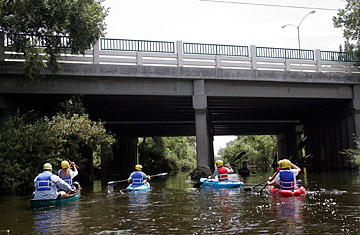
This summer, for the first time in nearly a century, Angelenos were legally allowed to paddle down one part of the Los Angeles River
As we kayaked, red-tailed hawks circled above us looking for food and snowy egrets played along the banks. A cormorant dived into the water next to me and leaped back to the surface just inches in front of my kayak. On a beach behind a small eddy, a fisherman angling for carp and bass caught a foot-long specimen and reeled it in for lunch. Yellow sticky monkey flowers poked out through glades of tall willows, sycamores and cottonwoods that hung over water where dragonflies hovered. Welcome to the Los Angeles River, in the middle of the San Fernando Valley in the city of Los Angeles.
"The L.A. what?" Ask people on the streets of Los Angeles about the city's river, and you'll get some strange looks. Some won't even know the city has one. Others will know it as a trickle of water and illegally dumped chemicals confined by graffiti-strewn concrete walls, because that's what they see from the freeways that pass over it. Still others envision a favorite burial ground for rusted shopping carts, old mattresses and refrigerators.
True, the 51-mile waterway — which stretches from Canoga Park through the valley, past Griffith Park and downtown Los Angeles on its way to Long Beach, where it lets out into the Pacific Ocean — is mostly locked by concrete. But there are several "soft-bottom" sections that resemble what the entire river once looked like. This summer, for the first time in nearly a century, Angelenos were legally allowed to paddle down one part of the river.
For Native Americans and early Spanish settlers, the waterway was a free-flowing source of drinking water that provided them a livelihood. But when Los Angeles grew, it didn't go the route of other U.S. cities that made their rivers a central landmark, lining them with parks and bike paths. After floods hit in the 1930s, authorities decided they needed to protect nearby homes, and they enclosed the river with concrete and turned it into a flood-control channel. It became a fenced-off no-man's-land operated by the Army Corps of Engineers. Residents weren't allowed to navigate the waters, so they started disassociating from it and even took to using it as an alternate garbage dump.
After years of local environmental groups and naturalists putting pressure on the county and the Army Corps, last year the U.S. Environmental Protection Agency declared the river a "traditional navigable waterway" subject to the protections of the Clean Water Act. That prompted activist and boater George Wolfe to organize an expedition down a soft-bottom section of the river near Griffith Park, which received a lot of local media attention and helped galvanize support for the river. In July, the Army Corps issued a license allowing the Los Angeles Conservation Corps to lead a pilot program down a 1.5-mile section of the river between Balboa and Burbank boulevards, and the Paddle the Los Angeles River program was launched. "I'm no longer this half-crazed maverick boater with the idea of boating down a river most people don't even recognize as a river," Wolfe says.
For Wolfe and environmental groups, opening up the river isn't just about having fun on a kayak. They see the pilot program as a first step toward taking out the concrete and turning the watershed back into a natural, trashless river again. "Think about how L.A. would look if we had a living river. It would be a much different and really a much more splendid city," Melanie Winter, director of the group the River Project, said as we drifted down the waterway. "Just because we've built out the way we have doesn't mean we can't retrofit to have it back. When you do that, you get parks and better public health and habitat, and you get a soul back in the city again."
That might help bring back respect for the river, which is sorely needed. Despite the sections of idyllic nature, the urban character of the river surfaces constantly. Kayaking down a ledge, my boat became stuck on a rusted shopping cart lurking in the water, and it took me a while to get free. I saw dozens more during the three-hour trip. My kayak sailed through clusters of trash including empty Styrofoam noodle containers, spray-paint cans and vitamin-bottle caps. The noise from airplanes overhead and cars on overpasses above the river spoiled the natural quiet. The water was undoubtedly full of pesticides from storm drains that empty into the waterway. As Ignacio Garcia, one of our guides from the Los Angeles Conservation Corps, put it: "It would be beautiful if there were no trash." In one section of the river, there was a faint but unwelcome smell not unlike sewage. "You get some unique odors around here," said a guide who goes by the name Ranger Tim, after I looked at him with a grimace.
Yet the elements of a real river trip were still there. We navigated around sandbars, portaged around rocky ledges and sailed by high arroyo walls eroded by flood wash. Andy Garcia, 31, who was fishing on a bank, said he often used the river to seek solace from the city. "I come here to relax and take it easy," said Garcia, who was surprised to see kayakers. Indeed, it's an outdoor experience unlike any other in L.A., a city mostly known for beaches, canyons and palm trees. If the pilot paddle program is any gauge, Angelenos seem to want to start treating the watershed as a river again. Tickets for the $50 river expeditions, which last through Sept. 25, sold out in just 10 minutes. "I need a ticket," said one person on the program's Facebook page. "WHAT!!! Sold out already!!" said another.
